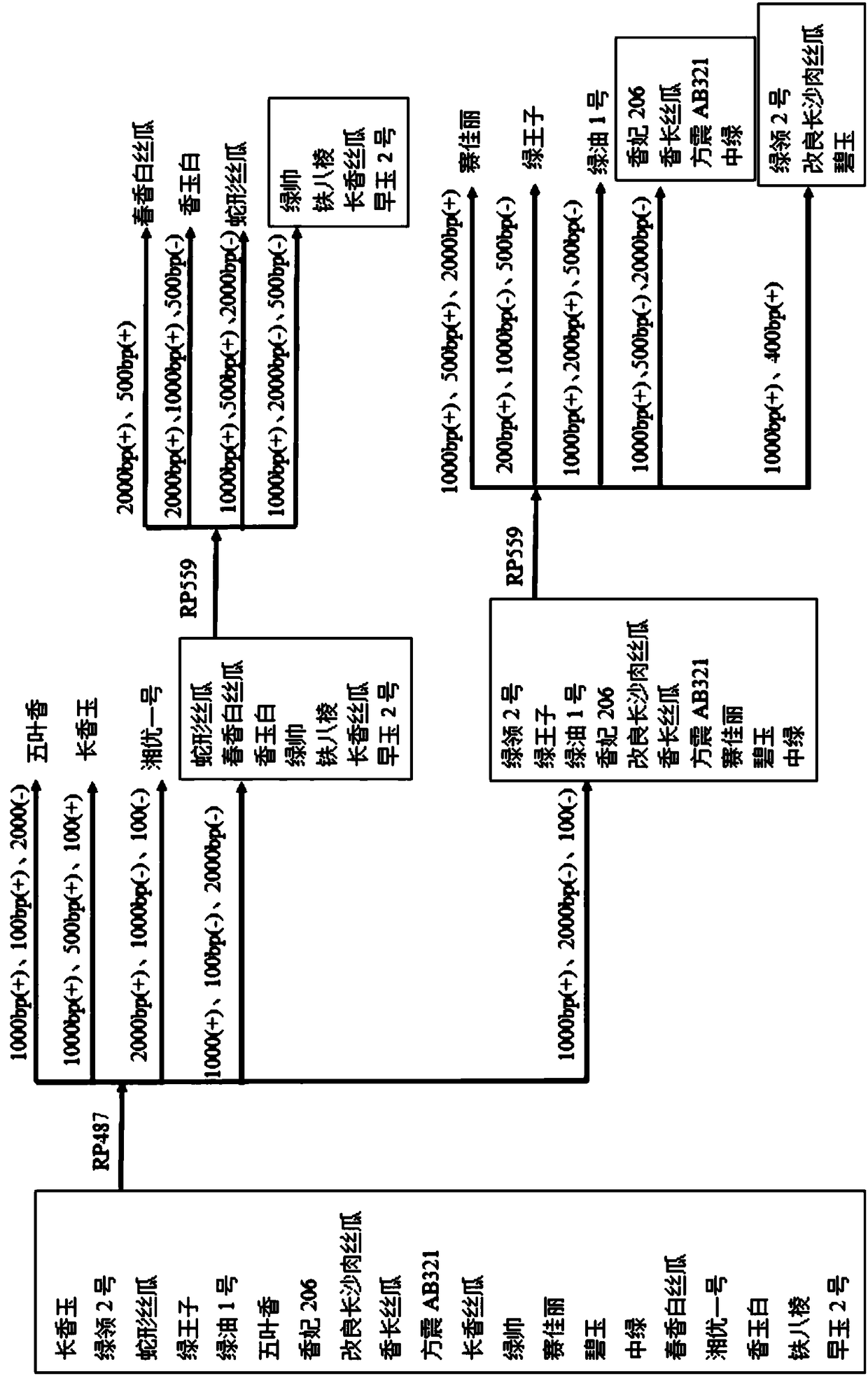RAPD primer for distinguishing varieties of Luffa cylindrica, and application thereof
The technology of a variety, loofah, applied in the field of molecular biology, can solve the problems of primers that cannot be visually displayed to distinguish varieties, large amount of operation, lack of practicability, etc., and achieve the effect of early identification, simple operation, and wide versatility
- Summary
- Abstract
- Description
- Claims
- Application Information
AI Technical Summary
Problems solved by technology
Method used
Image
Examples
Embodiment 1
[0056] Example 1: DNA extraction.
[0057] The loofah variety samples of the present invention are all common and important loofah varieties in the market, and the 20 varieties include: Changxiangyu, Lvling No. 2, Snake Luffa, Green Prince, Lvyou No. 1, Wuyexiang, Xiangfei 206, Improved Changsha loofah, fragrant long loofah, Fangzhen AB321, long fragrant loofah, Lvshuai, Saijiali, Jasper, Zhonglu, Chunxiang white loofah, Xiangyou No.1, Xiangyubai, Tiebaleng, Zaoyu No.2.
[0058] About 0.2 g of loofah leaves were used as material, ground with liquid nitrogen, and 500 μl of CTAB lysis solution (2% CTAB, 2M NaCl) was added. 2 , 20mM EDTA, 100mM Tris-HCl (PH=8.0) and 0.2% β-mercaptoethanol), transferred to a 1.5ml centrifuge tube, taken out and cooled in a water bath at 65°C for 0.5-1h, and an equal volume of chloroform:isoamyl alcohol ( 24:1) Shake the mixture gently, centrifuge the emulsion at 12000r / min for 8-10min, extract the supernatant with chloroform / isoamyl alcohol (24:1...
Embodiment 2
[0059] Example 2: RAPD-PCR reaction system and conditions.
[0060] RAPD-PCR reaction system is 20μl, containing 50ng genomic DNA, 2.0mmol·L -1 MgCl 2 , 0.15mmol·L - 1 dNTPs, 0.44 μmol·L -1 10mer primers, 0.75U Taq DNA polymerase.
[0061] The RAPD-PCR amplification procedure was pre-denaturation at 94°C for 2 min, denaturation at 94°C for 30S, annealing for 45S, extension at 72°C for 90S, 42 cycles, extension at 72°C for 10 min, and storage at 4°C. Amplification was carried out on a PCR amplifier, and the amplified products were electrophoresed on agarose gel (containing 1.2% ethidium bromide), 1×TAE electrophoresis buffer (1L contained: 0.242g Tris, 0.057ml glacial acetic acid, 0.2 ml 0.25mol / L EDTA pH 8.0). Add 4 μl of 6× loading buffer (containing 0.25% bromophenol blue, 30% sucrose) to the amplified DNA sample, and conduct electrophoresis at 120V constant pressure for 0.5-0.8 hours until the amplified DNA bands are clearly separated. , and then observed and photog...
Embodiment 3
[0062] Example 3: Stringent screening of specific primers.
[0063] The 4 primers of the present invention are obtained through strict screening of 52 originally designed random primers. First, 52 random primers were designed according to the genome of the existing loofah varieties, and 11 bases of RAPD random primers with good polymorphism, strong amplification and high stability were selected. Tape the same temperature as the annealing temperature. Specifically, the gradient PCR reaction system was 20 μl, containing 50 ng of genomic DNA, 2.0 mmol·L -1 MgCl 2 , 0.15mmol·L -1 dNTPs, 0.44 μmol·L -1 10mer primers, 0.75U Taq DNA polymerase. The reaction was pre-denatured at 94 °C for 2 min, denatured at 94 °C for 30 s, annealed for 45 s, extended at 72 °C for 90 s, 42 cycles, and extended at 72 °C for 10 min. The random primer sequence and annealing temperature of the present invention are as follows:
[0064] RP487: 5'-AGTCAGCCACG-3', annealing temperature 43.1℃;
[006...
PUM
 Login to View More
Login to View More Abstract
Description
Claims
Application Information
 Login to View More
Login to View More - R&D
- Intellectual Property
- Life Sciences
- Materials
- Tech Scout
- Unparalleled Data Quality
- Higher Quality Content
- 60% Fewer Hallucinations
Browse by: Latest US Patents, China's latest patents, Technical Efficacy Thesaurus, Application Domain, Technology Topic, Popular Technical Reports.
© 2025 PatSnap. All rights reserved.Legal|Privacy policy|Modern Slavery Act Transparency Statement|Sitemap|About US| Contact US: help@patsnap.com



